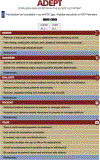Managing Delirium and Agitation in the Older Emergency Department Patient: The ADEPT Tool
- PMID: 31563402
- PMCID: PMC7945005
- DOI: 10.1016/j.annemergmed.2019.07.023
Managing Delirium and Agitation in the Older Emergency Department Patient: The ADEPT Tool
Abstract
Agitation and delirium are common reasons for older adults to seek care in the emergency department (ED). Providing care for this population in the ED setting can be challenging for emergency physicians. There are several knowledge translation gaps in how to best screen older adults for these conditions and how to manage them. A working group of subject-matter experts convened to develop an easy-to-use, point-of-care tool to assist emergency physicians in the care of these patients. The tool is designed to serve as a resource to address the knowledge translation and implementation gaps that exist in the field. The purpose of this article is present and explain the Assess, Diagnose, Evaluate, Prevent, and Treat tool. Participants were identified with expertise in emergency medicine, geriatric emergency medicine, geriatrics, and psychiatry. Background literature reviews were performed before the in-person meeting in key areas: delirium, dementia, and agitation in older adults. Participants worked electronically before and after an in-person meeting to finalize development of the tool in 2017. Subsequent work was performed electronically in the following months and additional expert review sought. EDs are an important point of care for older adults. Behavioral changes in older adults can be a manifestation of underlying medical problems, mental health concerns, medication adverse effects, substance abuse, or dementia. Five core principles were identified by the group that can help ensure adequate and thorough care for older adults with agitation or delirium: assess, diagnose, evaluate, prevent, and treat. This article provides background for and explains the importance of these principles related to the care of older adults with agitation. It is important for emergency physicians to recognize the spectrum of underlying causes of behavioral changes and have the tools to screen older adults for those causes, and methods to treat the underlying causes and ameliorate their symptoms.
Copyright © 2019 American College of Emergency Physicians. Published by Elsevier Inc. All rights reserved.
Conflict of interest statement
Figures
References
-
- Hustey FM, Meldon SW. The prevalence and documentation of impaired mental status in elderly emergency department patients. Ann Emerg Med. 2002;39:248–253. - PubMed
-
- LaMantia MA, Messina FC, Hobgood CD, et al. Screening for delirium in the emergency department: a systematic review. Ann Emerg Med. 2014;63:551–560.e2. - PubMed
-
- Kakuma R, du Fort GG, Arsenault L, et al. Delirium in older emergency department patients discharged home: effect on survival. J Am Geriatr Soc. 2003;51:443–450. - PubMed
-
- Barron EA, Holmes J. Delirium within the emergency care setting, occurrence and detection: a systematic review. Emerg Med J. 2013;30:263–268. - PubMed
Publication types
MeSH terms
Grants and funding
LinkOut - more resources
Full Text Sources
Medical



